Sunday, November 2, 2008
14156
Long Term of Survival of Penile Allotransplantation Model in Rat under Cyclosporin-A MonoTherapy
Purpose:
Penile defects may be caused by trauma, cancer surgeries, congenital anomalies and surgical complications. The treatment options for penile defects include: penile replantation, reconstruction and transplantation.
In this study we introduce an experimental model of penile allogenic transplantation based on neurovascular pedicle.
Methods:
42 adult male LEW (RT1l) and 6 adult male LBN (RT1l+n) rats weighing 200-300g were used in three experimental groups: Anatomic study (Group 1, n=6), isotransplantation (Group 2, n=24) and allotransplantation groups (Group 3, n=12).
In 6 LEW rats, the vascular anatomy of male rat perineal region was determined by anatomic dissections. The penile composite flap was created based on the corpus spongiosum, dorsal penile vein and dorsal penile nerves (Figure 1,2).
In order to reduce the morbidity and mortality of the recipient rats, instead of performing amputation of penis of the recipient rat, we have introduced modification of rerouting it into the scrotum. In 12 LEW rats, penile composite graft was transplanted as an isotransplant by microvascular anastomosis of the pedicle of the penis of the donor with the saphenous vessels of the recipient (Figure 3,4).
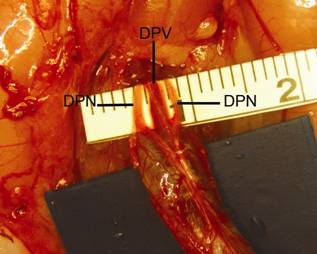 Figure 1. View of the isolated dorsal penile vein (DPV), and dorsal penile nerves (DPN) on the milimetric scale under operating microscope.
Figure 1. View of the isolated dorsal penile vein (DPV), and dorsal penile nerves (DPN) on the milimetric scale under operating microscope.
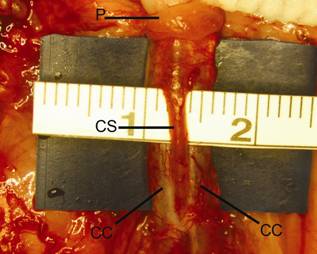 Figure 2. View of the isolated corpus spongiosum (CS) on the milimetric scale under operating microscope. (corpus cavernosum (CC), preputium(P)).
Figure 2. View of the isolated corpus spongiosum (CS) on the milimetric scale under operating microscope. (corpus cavernosum (CC), preputium(P)).
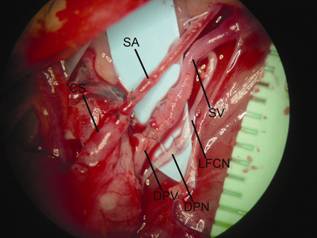 Figure 3. View of the anastomoses on the milimetric scale under operating microscope. (saphenous artery (SA), corpus spongiosum (CS), dorsal penile vein (DPV), saphenous vein (SV), dorsal penile nerve (DPN), lateral femoral cutaneous nerve (LFCN)).
Figure 3. View of the anastomoses on the milimetric scale under operating microscope. (saphenous artery (SA), corpus spongiosum (CS), dorsal penile vein (DPV), saphenous vein (SV), dorsal penile nerve (DPN), lateral femoral cutaneous nerve (LFCN)).
In another 12 LEW rats, penile composite graft was transferred as a composite graft without vascular anastomosis. In the third part of the study, penis composite graft was transplanted across MHC barrier between LBN donors and LEW recipients under tapered dose of CsA immunotherapy. Graft survival was monitored by daily observations, somatosensory evoked potentials, histological examination and microangiography to assess transplant viability.
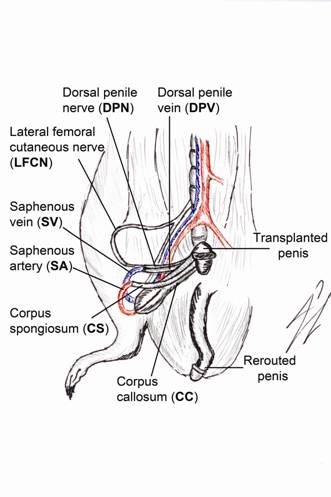 Figure 4. Drawing of the design of the transplantation procedure.
Figure 4. Drawing of the design of the transplantation procedure.
Results:
All vascularized isotransplants and allotransplants survived without signs of acute or chronic rejection over 200 days (still under observation) whereas all nonvascularized grafts underwent necrosis at 7 days post-transplant (Figure 5). Somatosensory evoke potential evaluation tests (SSEP) confirmed that starting at day 60 post-transplant, stimulation of the glans of the transplanted penis revealed cortical responses recorded in the somatosensory cortex of the recipient rat. Microangiographic evaluation of the transplanted penile tissues with lead oxide gelatin mixture demonstrated well preserved vascular territories of the transplanted penile allograft at 200 days post-transplant (Figure 6).
Histological evaluation confirmed that there were no signs of rejection at post-transplant day 200. Besides it was observed on the histological slides that the artery of the urethral bulb, cavernous structures of the corpus spongiosum, the dorsal penile arteries and the other small arterial branches were filled with the lead oxide gelatin mixture which was infused via intraarterial route (Figure 7).
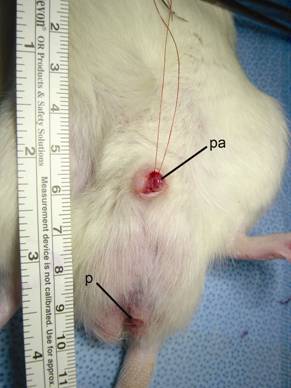 Figure 5. Allotransplant on 200th post-transplant day (rerouted penis to the scrotum (p), penis allotransplant (pa)).
Figure 5. Allotransplant on 200th post-transplant day (rerouted penis to the scrotum (p), penis allotransplant (pa)).
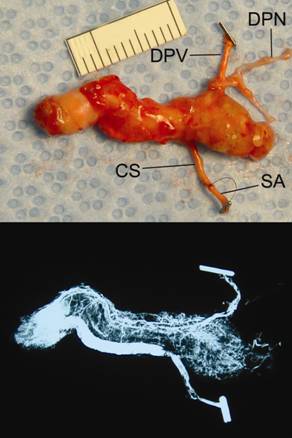 Figure 6. Allotransplant filled with intra arterial lead oxide-gelatin mixture (upper), and microangiographic view (lower). (saphenous artery (SA), corpus spongiosum (CS), dorsal penile vein (DPV), saphenous vein (SV), dorsal penile nerve (DPN).
Figure 6. Allotransplant filled with intra arterial lead oxide-gelatin mixture (upper), and microangiographic view (lower). (saphenous artery (SA), corpus spongiosum (CS), dorsal penile vein (DPV), saphenous vein (SV), dorsal penile nerve (DPN).
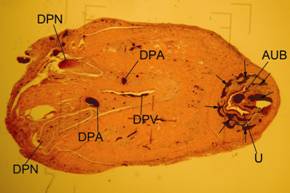 Figure 7. Histological examination of the penile tissue allotransplant on the 200th post-transplant day. Note the dorsal penile arteries (DPA), artery of the urethral bulb (AUB) and cavernous structures of the corpus spongiosum (arrows) filled with leadoxide. (x10, H&E staining).(urethra (U), dorsal penile nerve (DPN)).
Figure 7. Histological examination of the penile tissue allotransplant on the 200th post-transplant day. Note the dorsal penile arteries (DPA), artery of the urethral bulb (AUB) and cavernous structures of the corpus spongiosum (arrows) filled with leadoxide. (x10, H&E staining).(urethra (U), dorsal penile nerve (DPN)).
Conclusions:
This study confirmed feasibility of new penile allograft transplantation model. Long term survival without signs of rejection was achieved on tapered dose of Cyclosporin A monotherapy. The sensory function of penile transplant was confirmed by somatosensory evoked potentials. Finally, a new method of neurovascularization of penile transplant by direct artery-to-corpus spongiosum anastomosis was introduced.
